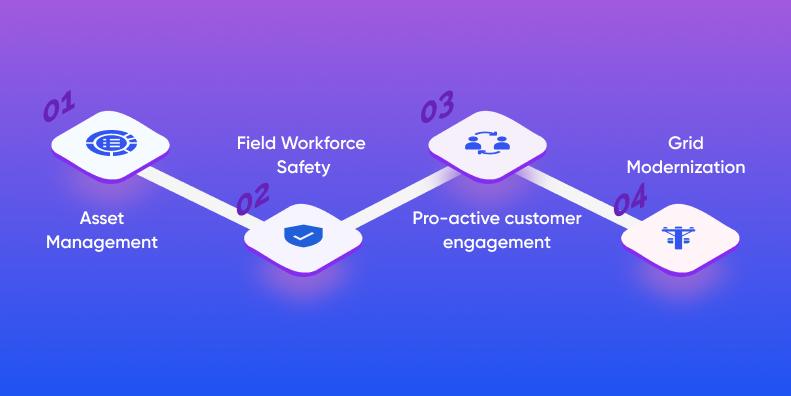Master Blog
Beyond the Map: Leverage Location Intelligence for Smart Utility Operations

Imagine a world where utilities can predict and prevent outages before they happen, where technicians arrive at the right place at the right time with all the necessary tools and equipment, where customers have a seamless experience with their utility providers. A world where utilities can optimize field workforce routes, ensuring the most efficient paths are taken to service multiple locations in a single trip.
Welcome to the world of Location intelligence for utilities, where data meets innovation to transform the way utilities operate. Let us deep dive into how it can help utilities optimize their field service operations, enhance customer satisfaction, and ultimately, drive business success.
As the world is becoming increasingly digitized, utilities face the ongoing challenge of delivering reliable and efficient services while managing costs. Field service operations, in particular, require a delicate balance between timely response and cost-effective resource deployment. This is where location intelligence emerges as a transformative tool, empowering utilities to make data-driven decisions that optimize their operations. As utilities operate across vast geographic areas, the need for location intelligence becomes even more crucial. Let’s explore the challenges utilities face and how location intelligence can revolutionize their field service operations, enhance customer satisfaction, and drive business success.
The utility industry faces several pivotal challenges that emphasize the imperative need for location intelligence. These include :
-
Insufficient Field Data and Workflow Inefficiencies: To prevent asset network failure, high-class quality field data with an effective workflow equipped with digital applications is not available for utilities. Utilities struggle with inadequate field data for preventing asset network failures, relying on inefficient methods such as hand-drawn maps. The migration of data into enterprise systems involves time-consuming procedures that hinder efficiency and accuracy.
Utilities struggle with inadequate field data for preventing asset network failures, relying on inefficient methods such as hand-drawn maps
-
Vulnerabilities and Inefficient Field Operations: Utilities face challenges such as outages, delays, and inefficient scheduling of field workforce, impacting customer satisfaction and overall operational performance.
-
Accessing and Sharing Geographic Data: Legacy datasets, improper scheduling, late adoption of new technologies, and subpar customer satisfaction hinder utilities' ability to access and share geographic data effectively. Data continues to be a challenge due to various factors:
-
Legacy Datasets – Physical paperwork, hand-drawn formats, reading and interpreting scanned forms and images require a lot of human interventions.
-
Improper Schedule – Intensive manual interventions to schedule field assignments, identify the right field agents, and dispatch at the right time.
-
Aging Workforce – Centralized operations provides dependency on ageing workforce thus impacting productivity and efficiency.
-
Late Adoption of New Technologies – Due to the intricate nature of their IT and physical asset infrastructure, utilities tend to be cautious adopters of new technologies, often lagging in embracing innovative solutions.
-
Customer Satisfaction – The failure to deliver prompt services and the occurrence of faulty assignments contribute to subpar customer experiences.
-
Location intelligence combines geographic information systems (GIS) technology with data analytics to provide utilities with a comprehensive understanding of their service territories. By analyzing data from various sources, such as weather forecasts, traffic patterns, and customer complaints, utilities can identify patterns and trends that can help them make more informed decisions.
Let's dive into some fascinating real-world applications of location intelligence in the utility industry:
-
Asset Management: Location intelligence enables effective asset management through GIS technology. Utilities can track spatial assets, predict failures, and maintain accurate records, leading to cost savings and improved reliability.With GIS-powered platforms, utilities can handle billions of asset-related data elements and access a real-time digital model of the entire network on any device. This allows the workforce to trace the path of any network on a mobile device and obtain information on the whereabouts of assets.
-
Workforce and Public safety: Accurate location details provided by location intelligence systems ensure the safety of field workers during maintenance and repair works. Utilities can improve regulatory compliance with real-time reporting using smart maps and enhance community safety by providing easy-to-understand maps during emergencies such as floods, storms, or power outages.
In Scotland, geospatial technology has enabled the monitoring of power outages during storms, providing auditable reports to the government and allowing utilities to send response units and restore power quickly by showing the location and numbers of affected customers.
-
Pro-active customer engagement: In today's competitive utility industry, customer engagement is a crucial factor for success. Geo intelligence platforms enable utilities to provide timely information to customers, engage with them directly, and offer updates on outages and restoration efforts. Integrating social media with location intelligence allows utilities to analyze customer complaints and respond effectively. Regular updates on social media can help customers make informed decisions during emergencies. Seattle's municipal utility exemplifies proactive monitoring of social media for any mentions of network issues. Leveraging GIS technology, they analyze the collected data and integrate it with other pertinent information on a performance dashboard for comprehensive insights.
-
Grid Modernization: Utilities are installing sensors in power grids to generate real-time data for field activities. However, managing and understanding such data is a challenge. Geo intelligence systems leverage real-time data from sensors in power grids, helping utilities understand performance and identify vulnerabilities. By using advanced technologies such satellite imagery and drones, utilities can accelerate the adoption of digital solutions for grid modernization. For example, the Australian National University is using 3D GIS to build a 100% renewable energy grid, creating realistic models to share with others.

The benefits of Location Intelligence for Utilities:
-
Improved Resource Allocation: Utilities can use location intelligence to optimize the allocation of their resources, including personnel and equipment. By tracking the location of their field service technicians in real-time, they can assign work orders more efficiently and make sure the right resources are in the right place at the right time. This ensures efficient assignment of work orders, reducing travel time and ensuring the right resources are deployed at the right time.
-
Enhanced Customer Service: By leveraging location intelligence, utilities can respond quickly and efficiently to customer needs, resulting in a better customer experience. Real-time tracking of customer locations reduces wait times and increases overall satisfaction.
-
Operational Efficiency: Location intelligence identifies inefficiencies in processes, allowing utilities to streamline operations. Analysis of field technicians' movement patterns helps optimize travel routes and improve overall efficiency.
-
Reduced Maintenance Costs: By eliminating unnecessary travel and optimizing maintenance processes, location intelligence reduces costs and minimizes associated risks. Utilities have saved millions of dollars through the use of GIS technology in field service management and achieved significant cost reductions in asset inspection. With the use of GIS technology in FSM, utilities have saved up to $1 million for every 1,000 miles of the network. Additionally, utilities have saved up to 40% on asset inspection costs using GIS.
The integration of advanced analytics, machine learning, and artificial intelligence will unlock the full potential of location intelligence, propelling utilities into a realm of heightened efficiency and innovation
Location intelligence possesses the transformative capability to revolutionize utilities, empowering them to optimize field service operations, enhance customer satisfaction, and drive cost reductions. Armed with invaluable insights derived from spatial data, utilities can make informed decisions and achieve unparalleled operational excellence. The integration of advanced analytics, machine learning, and artificial intelligence will unlock the full potential of location intelligence, propelling utilities into a realm of heightened efficiency and innovation. By embracing the power of location intelligence, utilities can confidently navigate towards a smarter, more sustainable future, leading the industry towards unprecedented heights of success.
Smart Mobile Workforce (SMW®) is the #1 digital workforce experience (WX) platform for energy, water & gas providers, worldwide. SMW® helps in intelligently managing the field operations to make the service experiences effortless for the end customers.





